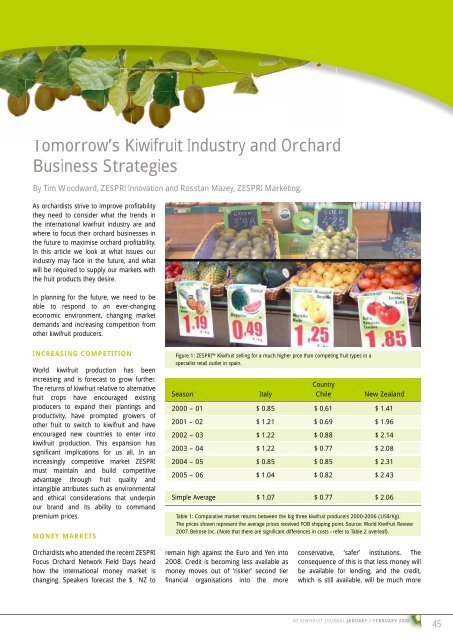Thirsty vines Summer girdling Compost teas Organic marketing The ...
Thirsty vines Summer girdling Compost teas Organic marketing The ...
Thirsty vines Summer girdling Compost teas Organic marketing The ...
You also want an ePaper? Increase the reach of your titles
YUMPU automatically turns print PDFs into web optimized ePapers that Google loves.
Tomorrow’s T<br />
Kiwifruit Industry and Orchard<br />
Business Strategies<br />
By Tim Woodward, ZESPRI Innovation and Rosstan Mazey, ZESPRI Marketing.<br />
As orchardists strive to improve profi tability<br />
they need to consider what the trends in<br />
the international kiwifruit industry are and<br />
where to focus their orchard businesses in<br />
the future to maximise orchard profi tability.<br />
In this article we look at what issues our<br />
industry may face in the future, and what<br />
will be required to supply our markets with<br />
the fruit products they desire.<br />
In planning for the future, we need to be<br />
able to respond to an ever-changing<br />
economic environment, changing market<br />
demands and increasing competition from<br />
other kiwifruit producers.<br />
INCREASING COMPETITION<br />
World kiwifruit production has been<br />
increasing and is forecast to grow further.<br />
<strong>The</strong> returns of kiwifruit relative to alternative<br />
fruit crops have encouraged existing<br />
producers to expand their plantings and<br />
productivity, have prompted growers of<br />
other fruit to switch to kiwifruit and have<br />
encouraged new countries to enter into<br />
kiwifruit production. This expansion has<br />
signifi cant implications for us all. In an<br />
increasingly competitive market ZESPRI<br />
must maintain and build competitive<br />
advantage through fruit quality and<br />
intangible attributes such as environmental<br />
and ethical considerations that underpin<br />
our brand and its ability to command<br />
premium prices.<br />
MONEY MARKETS<br />
Orchardists who attended the recent ZESPRI<br />
Focus Orchard Network Field Days heard<br />
how the international money market is<br />
changing. Speakers forecast the $ NZ to<br />
Figure 1: ZESPRI Kiwifruit selling for a much higher prce than competing fruit types in a<br />
specialist retail outlet in spain.<br />
Country<br />
Season Italy Chile New Zealand<br />
2000 – 01 $ 0.85 $ 0.61 $ 1.41<br />
2001 – 02 $ 1.21 $ 0.69 $ 1.96<br />
2002 – 03 $ 1.22 $ 0.88 $ 2.14<br />
2003 – 04 $ 1.22 $ 0.77 $ 2.08<br />
2004 – 05 $ 0.85 $ 0.85 $ 2.31<br />
2005 – 06 $ 1.04 $ 0.82 $ 2.43<br />
Simple Average $ 1.07 $ 0.77 $ 2.06<br />
Table 1: Comparative market returns between the big three kiwifruit producers 2000-2006 (US$/Kg).<br />
<strong>The</strong> prices shown represent the average prices received FOB shipping point. Source: World Kiwifruit Review<br />
2007. Belrose Inc. (Note that there are signifi cant differences in costs - refer to Table 2 overleaf).<br />
remain high against the Euro and Yen into<br />
2008. Credit is becoming less available as<br />
money moves out of ‘riskier’ second tier<br />
fi nancial organisations into the more<br />
conservative, ‘safer’ institutions. <strong>The</strong><br />
consequence of this is that less money will<br />
be available for lending, and the credit,<br />
which is still available, will be much more<br />
NZ KIWIFRUIT JOURNAL JANUARY / FEBRUARY 2008<br />
45


